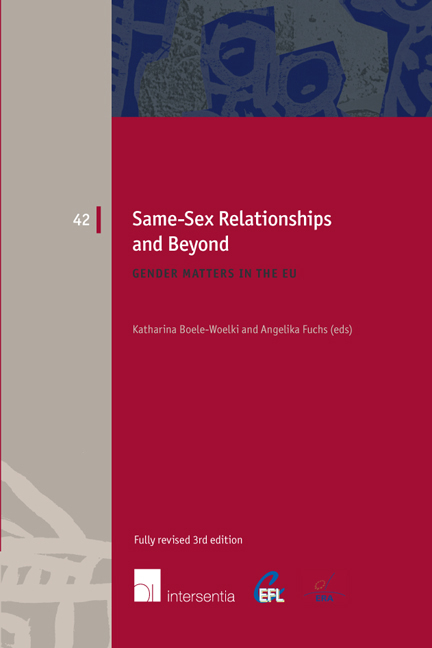Book contents
- Frontmatter
- Preface
- Contents
- List of Authors
- Part I Formalising a Same-Sex Relationship: Marriage and Partnership
- Part II Parenthood and Children's Rights
- Parenthood for Same-Sex Couples in the European Union: Key Challenges
- Recent Case Law on Cross-Border Surrogacy
- Law and Practice of Intercountry Adoption
- Part III Gender Identity and Human Rights
- EUROPEAN FAMILY LAW SERIES
Law and Practice of Intercountry Adoption
from Part II - Parenthood and Children's Rights
Published online by Cambridge University Press: 29 September 2018
- Frontmatter
- Preface
- Contents
- List of Authors
- Part I Formalising a Same-Sex Relationship: Marriage and Partnership
- Part II Parenthood and Children's Rights
- Parenthood for Same-Sex Couples in the European Union: Key Challenges
- Recent Case Law on Cross-Border Surrogacy
- Law and Practice of Intercountry Adoption
- Part III Gender Identity and Human Rights
- EUROPEAN FAMILY LAW SERIES
Summary
INTRODUCTION
The concept of adoption is evolving, which in turn presents challenges for many jurisdictions. We have witnessed a gradual shift towards simple/open adoption and a movement away from clean break adoption. One of the greatest challenges, however, in the area of adoption is in ensuring that we listen to and respond to the needs of children and that adoption continues to be a child-centred process meeting the needs of the individual child to be adopted.
Although the institution of adoption of children exists in most countries, there are different views as to the principles which should govern adoption, differences in the procedures for effecting adoption and different views on the legal consequences of adoption.
A number of international instruments are relevant, namely the 1993 Hague Convention, the European Convention on the Adoption of Children, the European Convention on Human Rights and the 1989 UN Convention on the Right of the Child. These instruments are discussed in detail below.
In Pini and others v. Romania, the European Court of Human Rights (ECtHR), citing Frett e v. France, stated that the rights of children should prevail over those of the parent in the case of a relationship based on adoption. It stated that ‘adoption means providing a child with a family, not a family with a child’.
Harmonisation should be a key social policy objective and strategy of any international instrument regulating adoption. The aim must be to achieve a greater unity between states for the purpose, amongst others, of facilitating their social progress. In Singh and others v. United Kingdom, the ECtHR held that the procedures involved in intercountry adoptions were aimed at protecting the interests and rights of the child and were not arbitrary obstacles to the adoption of children.
1993 HAGUE CONVENTION
The 1993 Hague Convention was the first international instrument to attempt to regulate intercountry adoption on a global basis.
- Type
- Chapter
- Information
- Same-Sex Relationships and BeyondGender Matters in the EU, pp. 143 - 160Publisher: IntersentiaPrint publication year: 2017



